Strength training is a critical component of a well-rounded fitness routine. If you find yourself consistently gravitating toward activities such as running, walking or cycling, consider supplementing your cardio-focused routine by performing resistance-training exercises at least two to three days non-consecutive days per week to build total body strength, boost bone mineral density and increase overall functional capacity. The following yoga poses utilize body weight and the support of props to enhance muscular strength and endurance, and to improve dynamic balance.
High-to-low Lunge Variation
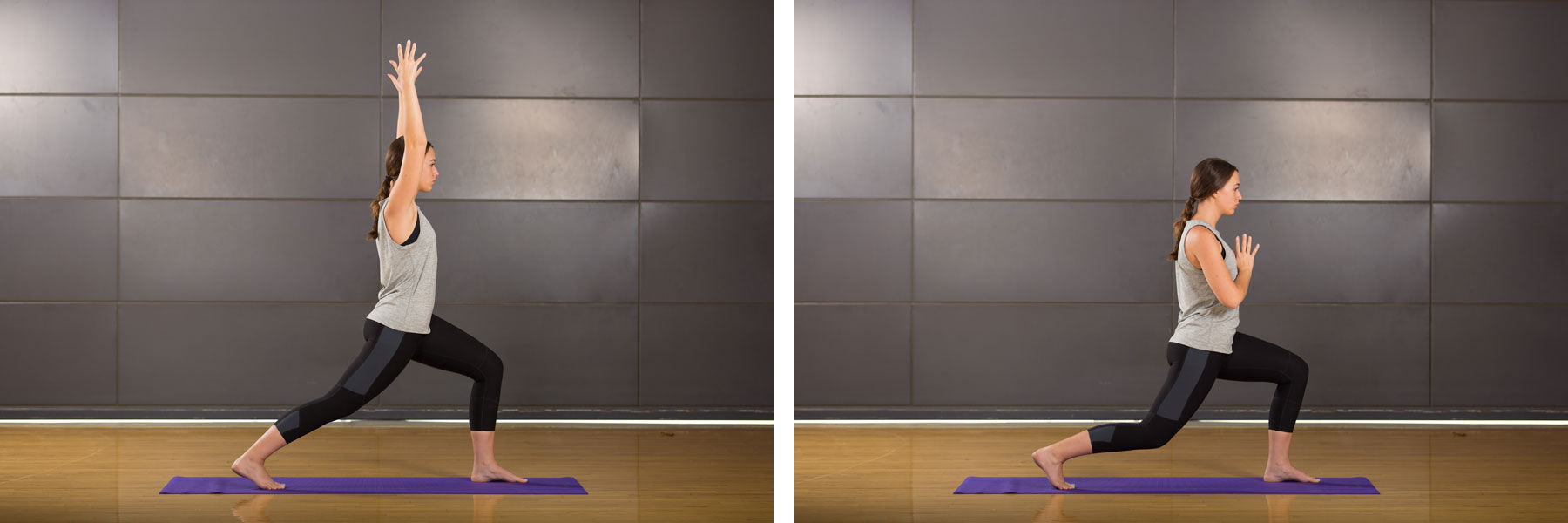
Stand with feet together at the top of a mat. With hands on the hips, step the left foot back approximately 3 to 4 feet. Keeping the left heel lifted to remain on the ball of the foot, slowly bend the right knee, keeping it aligned with the second toe of the right foot as the thigh draws toward parallel to floor. Inhale, sweeping the arms overhead; bring the palms to face one another while continuing to maintain a lunge position, actively pressing the left heel toward the back wall. Exhale to connect the palms overhead and then lower the hands to heart center while lowering the left knee until it hovers a few inches off of the mat. Inhale and re-extend the left leg, sweeping the arms up and returning to a high lunge position. Repeat this sequence of movements for three to five complete cycles of breath.
Chair Pose
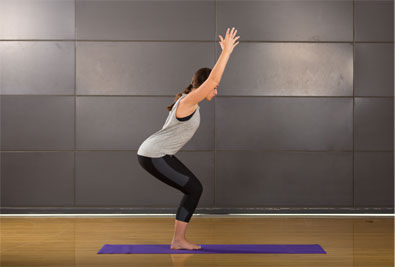
Stand near the top of a mat with feet together and arms alongside the body. As you inhale, hinge forward at the hips and bend the knees. Lower into a squat position while drawing the thighs toward parallel with the floor. Keeping both feet rooted firmly into the floor and the legs actively pressing together, exhale to lean the torso forward slightly, drawing the tailbone slightly down toward the mat (slight pelvic tilt) to avoid excessive arching in the lower back. Inhale once again, extending the arms toward the ceiling with palms facing one another with pinkies turned in slightly. Hold this position for three to five complete cycles of breath.
Supported Extended Side Angle

Stand at top of a mat with feet together; place a block at the tallest setting outside of the right foot. Step the left foot back 3 to 4 feet, turning the left toes toward the left side of the mat at almost a 90-degree angle; your chest should face the left side of the room. Align the heel of the front right foot with the arch of the back left foot. Slowly bend the right knee and move the thigh toward parallel with the floor, keeping the right knee aligned with the second toe of the right foot. Inhale, and extend the arms out wide in opposition, reaching toward the front and back edges of the mat while gazing over the right fingertips. Exhale to reach forward slightly with right fingertips and then release the right hand to rest atop the block. Draw the left fingertips toward ceiling, keeping the arms in line with the shoulders. If seeking more intensity, draw the left arm over the left ear, turning the palm to face the floor and reaching forward from the fingertips. Hold this position for three to five complete cycles of breath before switching sides and repeating.
Warrior I
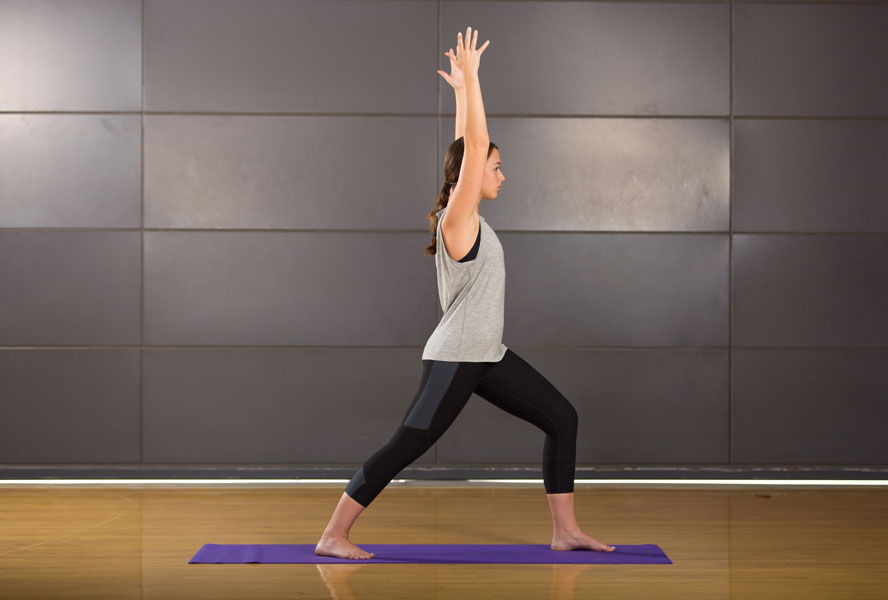
Begin standing with feet together near the front of a mat with hands on hips. Step the left foot back approximately 3 to 4 feet, turning the left foot out at a 45- to 60-degree angle. Align the heel of the front right foot with the heel of the back left foot, if accessible. Keeping both feet rooted firmly into the mat, slowly bend the right knee. Be sure to keep the right knee aligned with the second toe of the right foot as thigh draws toward parallel with floor. Gently guide the right shoulder and hip slightly back while drawing the left shoulder and hip slightly forward, squaring the shoulders and hips as much as accessible toward the front edge of the mat. Inhale to extend arms overhead with palms facing one another, pinkies turned in slightly. Exhale to soften the shoulders away from the ears while maintaining a neutral spine and depth in the posture. Hold this position for three to five complete cycles of breath before switching sides and repeating.
One-legged Upward Salute to Airplane Pose
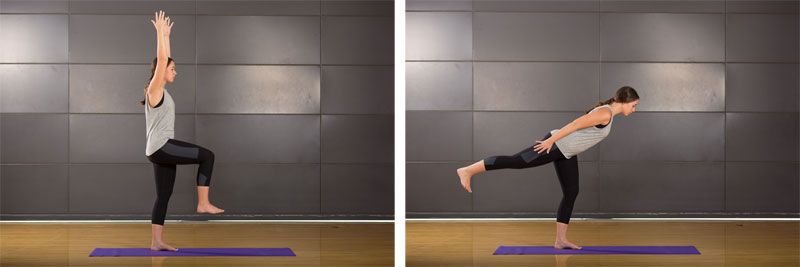
Stand slightly forward on a mat with feet together, arms alongside the body. Inhale to sweep the arms overhead, shifting your weight to the right foot to lift the left foot off the mat while keeping the knee bent at a 90-degree angle and the hips in line with one another. From this one-legged balancing position with a slight bend in the right knee, exhale to lean the torso forward, extending the arms alongside the body. Bring the palms to face one another, gently lifting through the chest to draw the shoulder blades together. At the same time, allow the left leg to extend and draw parallel to the floor, actively pressing the left heel toward the back of the room while keeping the hips squared toward the mat. Inhale once again to bend the left knee and re-extend the arms overhead, returning to the starting one-legged balancing position. Repeat this sequence of movements for three to four complete cycles of breath before switching sides and repeating, tapping the left foot down as needed between movements.
Supported Four-limbed Staff Pose
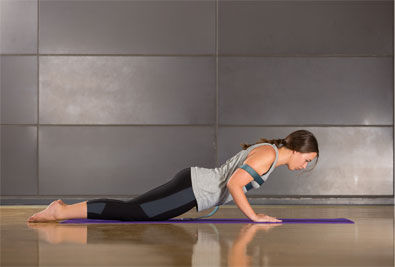
Begin in a high-kneeling position toward the back of a mat. Create a hip-width sized loop with a strap and place it around the upper arms, just above the elbows. Assume an extended table-top position, placing the hands just slightly beyond the shoulders while keeping the knees on the floor, hip-width distance part. Inhale to shift the chest slightly forward, drawing the heart between the thumbs while keeping the core engaged. Exhale to slowly bend the elbows, keeping them close to your body as you lower halfway down; begin to draw the upper arms toward parallel with the floor. The use of the strap helps to promote safe alignment in the pose as you work toward building strength. It helps you keep the elbows close to the body and in line with the shoulders while also supporting the ribs to create awareness of proper depth in the pose to protect the shoulders. For more intensity, this pose can also be performed from a high-plank position on toes with legs fully extended, heels pressing toward the back wall. Hold the lowest part of the pose for one to two cycles of breath before pressing back up to the starting position and taking a brief moment of rest. Repeat a total of four to five times, focusing on core engagement and overall alignment.
Locust Pose Variation
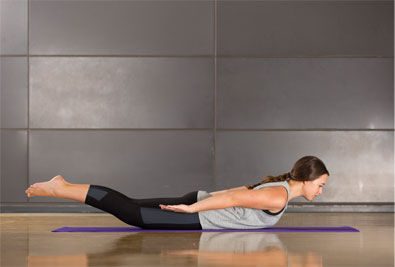
Lie in a prone position on a mat with the arms extended alongside the body and the legs either together to touch or parted just shy of hip-width distance. Depending on your level of comfort, you may choose to position the palms to face toward one another, or to remain open toward the ceiling. Maintaining length in the spine, inhale to lift the chest and thighs off the floor, actively stretching through the fingertips and toes. As you exhale, maintain this lifted position, keeping the neck in a neutral position by gazing a few inches out beyond the front edge of the mat on the floor. Hold this position for three to five complete cycles of breath.
Boat Pose Variation
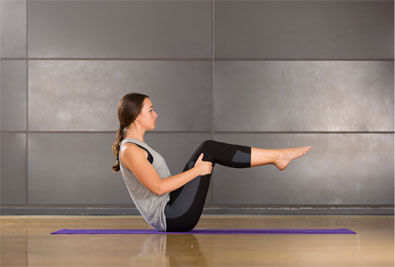
Assume a seated position on the mat with knees bent and feet flat on the floor. Lightly hold the backs of the thighs with the hands to gently lift the chest; maintain an extended spine. Keeping the core engaged, recline the torso back slightly without rounding the spine. Inhale to gently lift the right foot off the floor, drawing the right thigh parallel to the mat. Exhale to lift the left foot off the floor, drawing the left thigh parallel to the mat, continuing to lightly hold the backs of the thighs for support. Inhale once again to extend the arms, reaching the fingertips either forward toward your elevated feet or toward the ceiling, depending on your preferred level of intensity. Hold this position for three to five complete cycles of breath.




 by
by 




 by
by